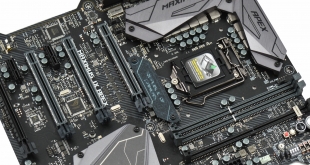
Very rarely does a motherboard company release a product that is genuinely different and innovative, bucking wider trends in the industry. ASUS has done exactly that with its new Republic of Gamers motherboard, the Maximus IX Apex.

The ASUS Maximus IX Apex is a very different class of motherboard to the norm, even by Republic of Gamers' unusual standards. The Apex takes most of its design philosophy from the overclocking-centric Maximus Extreme, with a heavy focus on LN2 and water cooling. It doesn't look too dissimilar to the rest of the ASUS ROG range, minus some of the more stylistic elements, but has many eye-catching novelties.
The most obvious of those is the non-rectangular shape, but also the fact there are now only two DDR4 slots and only 4 SATA ports plus a strange DIMM-type slot for M.2 drives. There's a typical array of overclocking buttons, switches, jumpers and headers that aren't unusual on an overclocking motherboard but also a mammoth 10 fan headers thrown into the mix.
The design is somewhat contradictory, more so than normal for a Republic of Gamers motherboard. Is the Apex targeting extreme overclockers with its LN2 focus or is it perhaps geared towards water cooling with its array of water cooling specific features? Its LED lighting and 3D Printing suggests it could also be aimed at modders too, but then it's a Republic of Gamers motherboard so it is still, at heart, intended for a gaming audience.
| ASUS ROG Maximus IX Apex |
|
| Form Factor | E-ATX, 30.5 cm x 27.2 cm |
| CPU Socket | LGA 1151, 10 Phase (8+2) |
| Chipset | Intel Z270 |
| Memory | DDR4, 2 DIMMs, up to 32GB, up to 4266MHz+ with OC, 2 Phase VRM |
| Onboard Graphics | Intel HD Graphics (supported CPUs), up to 1024MB of video memory |
| Discrete Graphics | Up to Nvidia 2-way/Quad SLI, AMD 4-way/Quad CrossFireX |
| Expansion Slots | 2 x PCIe 3.0 x16 (x16/x0 or x8/x8 – CPU lanes) 2 x PCIe 3.0 X16 (x4/x4 – chipset lanes) 2 x PCIe 3.0 X1 (chipset lanes) |
| Storage | 4 x SATA III (PCH) 2 x M.2 (via DIMM.2 adapter) |
| USB | 2 x USB 3.1 (2 Rear (1 Type-A and C) via ASM2142) 8 x USB 3.0 (6 Rear, 2 Front, via PCH) 6 x USB 2.0 (6 Front, via PCH) |
| Networking | 1 x Intel I219V |
| Audio | Realtek ALC1220 7.1 Channel HD Audio |
| Fan Headers | 10 (1 x CPU, 1 x CPU_OPT, 1 x W_PUMP+, 1 x AIO_PUMP, 3 x CHA, 3 x FS (Full Speed)) |
| Rear I/O | 1 x PS/2 keyboard (purple) 1 x PS/2 mouse (green) 1 x DisplayPort 1 x HDMI 1 x LAN (RJ45) port(s) 2 x USB 3.1 ()Type-A + Type-C 6 x USB 3.0 1 x Optical S/PDIF out 1 x Clear CMOS button(s) 1 x USB BIOS Flashback Button(s) 5 x Gold-plated audio jacks |
| UEFI | UEFI AMI |
 KitGuru KitGuru.net – Tech News | Hardware News | Hardware Reviews | IOS | Mobile | Gaming | Graphics Cards
KitGuru KitGuru.net – Tech News | Hardware News | Hardware Reviews | IOS | Mobile | Gaming | Graphics Cards

They really should keep the LN2 features away from consumer boards, because consumers are never, ever going to use LN2 on them at all. It’s just a ploy to crank the price up with an unnecessary feature most will never use.
Same goes for the automatic overclocking stuff. No-one who spends £300 on a motherboard will be using that. At all. If a total newbie is going to get into PC stuff and has stupid money to burn, they’ll pay for OCUK or Scan to do it out of the box with warranty.
The most striking feature of this board is the M.2 DIMM socket and weird shape (which puts me off slightly as it will reduce the stability of the board in terms of bending).
And, as with all motherboards, there’s barely a difference worth bothering with in terms of performance. When I choose a board I choose one with enough sockets to do what I want and has the most appropriate features such as VRM cooling, USB sockets and fan headers.